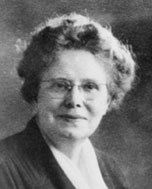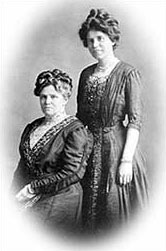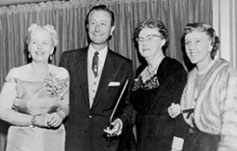
While her name does not carry the instant recognition across campus that some of our others may enjoy, one of our many prominent Lewis Institute graduates is Ethel Percy Andrus. Andrus was the founder in 1947 of the National Retired Teachers Association (NRTA) and in 1958 of AARP (formerly the American Association of Retired Persons), and was honored by U.S. presidents for her work in the non-profit world.
Andrus attended Lewis Institute from 1900 to 1901, receiving her Associate Degree upon completion of two years of study. Lewis was the first (and only, at that time) U.S. college to offer a degree-granting two-year program, and Andrus transferred to the University of Chicago where she completed the requirements for a Bachelor of Philosophy (Ph.B) degree in 1903.
Upon leaving the University of Chicago, Andrus returned to Lewis Institute, this time as a faculty member. From 1903 to 1910, she was on the faculty teaching English. Her direct connection with Lewis ended in 1910, when, for health reasons, she returned to her native California. In a letter dated June 15, 1910, Andrus described how much she hated to write the letter that would sever her connection with her two “greatest benefactors,” George N. Carman and Edwin H. Lewis (the school’s director and dean, respectively) and the institution that she holds dearest on earth. She wrote, “I shall always hold dear the memory of the most generous and devoted director a school or faculty might have.”
A Career in Service
Andrus’ reputation at the school continued long after her departure and her career was heralded by those who watched her mature into a capable teacher and academic administrator.
Andrus received an appointment at Manual Arts High School in Los Angeles and became acting principal in 1915. In February 1916, she was offered the position of vice principal at East Los Angeles High School, and in June was named principal. At age 32, she became the first woman high school principal in California.
Lincoln High School’s 2,500 students were mostly from poor families, representing a range of ethnicities and races who spoke 32 different languages. The school had one of the highest delinquency rates in the country. Andrus had a goal: “To bring to each [student] a sense of his own worth by treating him with dignity and respect, by honoring his racial background not as a picturesque oddity, but as a valued contribution in the tapestry of American life.” (Modern Maturity, Memorial Edition, January 1968, p. 25) Her volunteer work with the residents and clients at the Chicago Commons and Hull-House, while at IIT, had served her well as preparation for this.
Andrus worked to instill in her students both a community spirit and “the spirit of democracy—the spirit of strenuous effort, the spirit of loyal and united support.” (Modern Maturity, Memorial Edition, January 1968, p. 17) She instituted school assemblies, sports events, dances and other social activities to try to break down the ethnic and cultural barriers separating students.
As a result, the school’s delinquency rate dropped dramatically. The County Judge of Juvenile Court awarded Dr. Andrus and her school a special citation for success in youth crime prevention. Years later, one student recalled, “Somehow you found yourself acting the way she wanted you to.”
Organization Building
As a volunteer on the Welfare Committee of the California Retired Teachers Association, Andrus saw firsthand the economic plight of retired educators in the post-Depression era: pensions without automatic cost-of-living increases, loss of personal savings, lack of health insurance and deplorable living conditions. She was galvanized to action to advocate on behalf of these retired teachers, especially after discovering a retired teacher living in a chicken coop in a town outside of Los Angeles. Dr. Andrus’ secretary, Virginia Schott, shared in a 2001 oral-history interview that, decades later, when remembering her discovery of this retired colleague living in such deplorable conditions, Dr. Andrus’ anger was still keen.

In October 1947, the National Retired Teachers Association (NRTA) was founded at a meeting of the California Retired Teachers Association in Berkeley. Andrus was elected NRTA president, a volunteer position. Andrus and her colleagues focused their legislative advocacy efforts on a campaign to eliminate mandatory retirement; gain access to health-care insurance for people over age 65; protect public employees, including teachers, from having their state and local pensions replaced with lower federal Social Security benefits; and gain exemption of retirement income from federal income tax.
In 1950, NRTA won its first legislative battle. Legislation was passed that excluded members of existing state or local pension plans from the Social Security program. The fight to get health insurance for the retired teachers took longer. At the time, it was an accepted insurance industry standard that it was not fiscally sound to offer health insurance to anyone aged 65 or older. (Medicare would not become available until July 1, 1966.)
Thousands of older Americans not eligible for NRTA membership contacted the Association wanting to know how they could obtain health insurance and other NRTA benefits if they were not retired teachers. Andrus worked with Davis to see if they could provide similar health insurance coverage for the general population of retired persons. They set out to start a new association.
The AARP today
On July 1, 1958, AARP was incorporated in the District of Columbia. Its four official goals were to: 1) Enhance the quality of life for older persons, 2) Promote independence, dignity and purpose for older persons, 3) Lead in determining the role and place of older persons in society, and 4) Improve the image of aging. Andrus created the motto for AARP: “To Serve, Not To Be Served.”
Andrus served as AARP’s first president, a volunteer position, and as editor of AARP’s magazine, Modern Maturity, now known as AARP The Magazine. In that first issue, she stated her position on aging: “Aging is not a problem; it represents a real and thrilling challenge. It is one thing to recognize that older people represent the nation’s greatest single human resource available, and it is quite another to do something about it.”
Andrus was selected to serve on the national advisory committee for the first White House Conference on Aging, held in January 1961, near the end of President Eisenhower’s term. Out of this national meeting came the impetus for final passage of Medicare and other important initiatives. Andrus received numerous awards and recognition during her life, including National Teacher of the Year from the National Congress of Parents and Teachers and the National Education Association (1954). She was the first teacher in the nation to receive the Golden Apple Award from the International Senior League (1954).

In 1963, Andrus suffered a heart attack that her doctor believed would leave her unable to ever work again. But the next morning, she awakened early and asked for paper and pencil so she could write a Modern Maturity editorial. Soon, she was out of the hospital and back traveling, speaking and writing. On July 9, 1967, Andrus completed her last magazine editorial for the October-November issue of Modern Maturity. She died of a heart attack four days later, at age 82, in Long Beach, California.
President Lyndon Johnson wrote upon Andrus’ death: “The life of each citizen who seeks relentlessly to serve the national good is a most precious asset to this land. And the loss of such a citizen is a loss shared by every American. In Ethel Percy Andrus, humanity had a trusting and untiring friend. She has left us all poorer by her death. But by her enduring accomplishments, she has enriched not only us, but all succeeding generations of Americans.”
In 1968, AARP and NRTA published a collection of Andrus’ editorials, The Wisdom of Ethel Percy Andrus. Among the testimonials, William D. Bechill, first Commissioner on Aging, U.S. Department of Health, Education and Welfare, wrote: “Dr. Andrus was one of the first to realize that our nation was neither seriously facing the questions of meaningful use of the retirement years nor concerned enough with a place of respect and purpose of older people in the world around us. She was a pioneer in both organizational effort by older people themselves and in ideas for the advancement and enhancement of their personal status and prestige. And, she knew how to fight hard and be persistent about what she believed was right.”
In order to establish a living memorial to Andrus, AARP and NRTA approved a plan in 1968 for the Ethel Percy Andrus Gerontology Center at the University of Southern California. The agreement was that AARP and NRTA would raise $2 million and the university would match it. Within two years, the memorial fund had $2,750,000. The Andrus Gerontology Center opened in 1973. AARP honors Andrus’ legacy with its annual AARP Andrus Award for Community Service, which recognizes outstanding AARP volunteers and members in every state who are making a difference in their communities.
Today, the organization that Andrus founded represents more than 35 million members age 50+, about half of whom are working, either full- or part-time. AARP has staffed offices in all 50 states, the District of Columbia, Puerto Rico and the U.S. Virgin Islands. AARP continues to provide information and resources; engage in legislative, consumer and legal advocacy; assist members in serving their communities through volunteer opportunities; and offer a wide range of products and services for members through AARP Services, Inc. (ASI), a wholly owned subsidiary of AARP. The Association remains true to Andrus’ vision of an organization that is a leader in positive social change and of individuals aging with dignity, independence and purpose.
Lily Liu, AARP History Consultant, invites readers with information related to Dr. Andrus’ connections to Lewis Institute to contact her at LLiu@aarp.org or (202)434-6224. Catherine Bruck, the university archivist, helped contribute to this article.